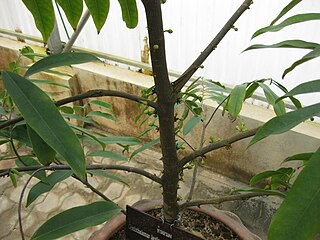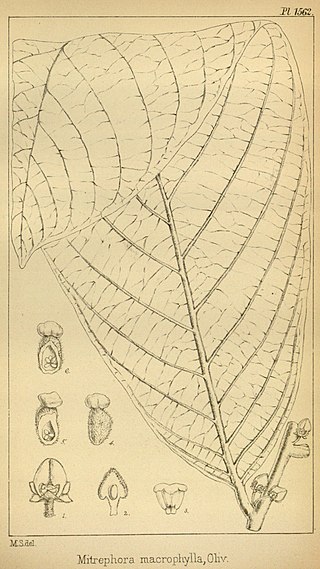
The stamen is the pollen-producing reproductive organ of a flower. Collectively the stamens form the androecium.

Gynoecium is most commonly used as a collective term for the parts of a flower that produce ovules and ultimately develop into the fruit and seeds. The gynoecium is the innermost whorl of a flower; it consists of pistils and is typically surrounded by the pollen-producing reproductive organs, the stamens, collectively called the androecium. The gynoecium is often referred to as the "female" portion of the flower, although rather than directly producing female gametes, the gynoecium produces megaspores, each of which develops into a female gametophyte which then produces egg cells.

Leea is a genus of plants that are distributed throughout Northern and eastern Australia, New Guinea, South and Southeast Asia and parts of Africa. The APG IV system places Leea in the subfamily Leeoideae (Vitaceae). Leea is now placed in the family Vitaceae having previously been placed in its own family, Leeaceae, based on morphological differences between it and other Vitaceae genera. These differences include ovule number per locule, carpel number, and the absence or presence of a staminoidal tube and floral disc. Pollen structure has also been examined for taxonomic demarcation, though studies have concluded that the pollen of Leeaceae and Vitaceae suggests the families should remain separate while other studies conclude that Leea should be included in Vitaceae.

Alphonsea is a genus of plant in the family Annonaceae. As of April 2014 The Plant List recognises 38 accepted species:

Goniothalamus is one of the largest palaeotropical genera of plant in family Annonaceae.

Polyalthia is a genus of flowering plants in the family Annonaceae. There are approximately 90 species distributed from Africa to Asia and the Pacific.
Cyathocalyx is a small genus with about 22 species distributed from southern India, Sri Lanka, through Malaysia, Indomalayan islands and reaches as far as Fiji in the South Pacific.

Meiogyne is a genus of flowering plants with about 28 species belonging to the family Annonaceae. It is native from southwestern India and Indochina to Australia, including Fiji and New Caledonia.

Artabotrys is a genus of plants in the Annonaceae family. There are over 100 species in the Old World tropics, with 31 species in Africa. It is part of the custard apple family (Annonaceae). All species are small trees or shrubs with a tendency to climb. Leaves are simple and alternate, without hairs. Bisexual flowers are borne singly or in clusters opposite the leaves. The 6-petalled flowers are scented, and the plant bears fleshy fruits.

Ottelia is a genus of an aquatic plant family Hydrocharitaceae described as a genus in 1805. The genus is native to tropical and subtropical regions of Africa, Asia, South America, and Australia.
Goniothalamus elegans is a species of plant in the family Annonaceae. It is native to Thailand and Vietnam. Suzanne Jovet-Ast, the French botanist who first formally described the species, named it after its elegant thin, flexible leaves.

Goniothalamus laoticus is a species of plant in the family Annonaceae. It is native to Laos and Thailand. It was originally described by the French botanists Achille Eugène Finet and François Gagnepain using the basionym Mitrephora laotica. In Thailand it is commonly called Khao Lam-dong and is used as a traditional medicine.
Goniothalamus gabriacianus is a species of plant in the family Annonaceae. It is native to Cambodia, the province of Hainan China, Laos, Thailand and Vietnam. Henri Ernest Baillon the French botanist who first formally described the species using the basionym Oxymitra gabriaciana, named it after Paul-Pierre Gabriac, a French civil servant in Vietnam, who provided one of the specimens that he examined.
Goniothalamus tamirensis is a species of plant in the family Annonaceae. It is native to Cambodia, Laos, Peninsular Malaysia, Thailand and Vietnam. The French botanists J.B. Louis Pierre and François Gagnepain, who first formally described the species, named it after the region in Cambodia it was collected from, which they record as “monts Tamir”.
Mitrephora calcarea is a species of plant in the family Annonaceae. It is native to Laos and Vietnam. Aruna Weerasooriya and Richard M.K. Saunders, the botanists who provided the first valid formal description of the species, named it after the limy soil it grows in. The name follows a prior invalid account by Suzanne Jovet-Ast, which lacked a Latin description.
Pseuduvaria luzonensis is a species of plant in the family Annonaceae. It is native to The Philippines. Elmer Drew Merrill, the American botanist who first formally described the species using the synonym Orophea luzoniensis, named it after Luzon in the Province of Battan, Philippines where the specimen he examined was collected along the Lamao River.

Pseuduvaria macrophylla is a species of plant in the family Annonaceae. It is native to Peninsular Malaysia, Sumatra and Thailand. Daniel Oliver, the English botanists who first formally described the species using the synonym Mitrephora macrophylla, named it after its large leaves.
Pseuduvaria philippinensis is a species of plant in the family Annonaceae. It is native to the Philippines. Elmer Drew Merrill, the botanist who first formally described the species, named it after the Philippines where the specimen he examined was collected in the Province of Quezon.

In botany, floral morphology is the study of the diversity of forms and structures presented by the flower, which, by definition, is a branch of limited growth that bears the modified leaves responsible for reproduction and protection of the gametes, called floral pieces.













